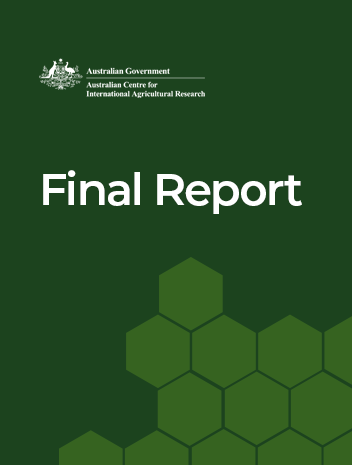- HomeHome
-
About ACIAR
- Our work
- Our people
-
Corporate information
- ACIAR Audit Committee
- Commission for International Agricultural Research
- Policy Advisory Council
- Agency reviews
- Executive remuneration disclosure
- Freedom of information (FOI)
- Gifts and benefits register
- Information publication scheme
- List of new agency files
- Contracts
- Legal services expenditure
- Privacy impact assessment register
- Commonwealth Child Safe Framework
- Benefits to Australia
- Careers
- 40 years of ACIAR
-
What we do
- Programs
- Cross-cutting areas
- Resources
- Where we work
-
Funding
- Research projects
- Fellowships
-
Scholarships
- John Allwright FellowshipScholarships to study in Australia for ACIAR partner country scientists to have Australian postgraduate qualifications
- ACIAR Pacific Agriculture Scholarships and Support and Climate Resilience Program
- Alumni Research Support Facility
- Publications
- News and Outreach
Project final report
Sustainable wheat and maize production in Afghanistan - final report
Date released
01 June 2019
ISBN
978-1-925747-17-1
Publication Code
CIM/2011/026
Overview
This project aimed to introduce new, high-yielding, drought-tolerant and disease-resistant varieties of wheat and maize to Afghanistan.
Afghanistan has one of the highest per capita wheat consumptions in the world but does not produce enough to meet domestic demands. Afghan wheat research lacks a home-grown wheat breeding programme, and research in other disciplines also needs support to develop and disseminate useful implementable technologies.
Funded by the Australian Department of Foreign Affairs and Trade, this project, implemented by the International Centre for Wheat and Maize Improvement (CIMMYT), introduced much-needed improved wheat and maize varieties into the country. It aimed to make higher-yielding wheat varieties in a water-limited environment available to Afghan farmers. The new wheat varieties needed to be resistant to the rust diseases of wheat, particularly the threatening stem rust strain ug99 and the widespread yellow (stripe) rust.
The project also tested and demonstrated appropriate and adoptable improvements to cropping practices (such as line sowing of wheat, without tillage). Seeds of released improved varieties are scarce, so the project also explored how communities could produce seeds.



